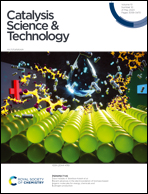Carbon nanotube/PTFE as a hybrid platform for lipase B from Candida antarctica in transformation of α-angelica lactone into alkyl levulinates†
Abstract
In this work an enzymatic method for the synthesis of alkyl levulinates from α-angelica lactone has been reported for the first time. Lipase B from Candida antarctica was immobilized via interfacial activation on the surface of a hybrid support, consisting of commercially available multi-walled carbon nanotubes (MWCNTs) and polytetrafluoroethylene (PTFE). Among the biocatalysts with various contents of PTFE in the support, the CALB/MWCNT–PTFE (0.10 wt%) biocatalyst with 22.5 wt% CALB loading was determined as the most active one in the model synthesis of the n-butyl levulinate in toluene. n-Butyl levulinate was obtained quantitively after 120 min of the reaction under the selected reaction conditions (2-fold molar excess of n-butanol, 0.150 g of biocatalyst per 1 mmol of α-angelica lactone, 20 °C). The yield of n-butyl levulinate was found to be higher than that in the presence of accurate amounts of sulfuric acid or Novozyme-435. Additionally, the unique stability of the developed biocatalyst was demonstrated over 6 reaction cycles at 20 °C. The biocatalyst remained stable over 3 reaction cycles at 60 °C as well. The essence of the proposed approach lies in the possibility to overcome the equilibrium limitations occurring in the conventional Fisher esterification. The activity of the elaborated hybrid biocatalyst in the reactions non-specific for lipases is a clear proof of the versatility of the novel system.



 Please wait while we load your content...
Please wait while we load your content...